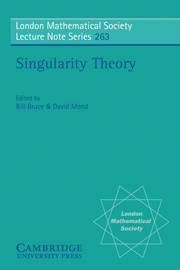 Singularity Theory
Singularity Theory Book contents
- Frontmatter
- Contents
- Preface
- Introduction
- Summaries of the Papers
- Complex Singularities
- Stratifications and Equisingularity Theory
- Differential Forms on Singular Varieties and Cyclic Homology
- Continuous Controlled Vector Fields
- Finiteness of Mather's Canonical Stratification
- Trends in Equisingularity Theory
- Regularity at Infinity of Real and Complex Polynomial Functions
- Global Singularity Theory
- Singularities of Mappings
- Applications of Singularity Theory
- References
Trends in Equisingularity Theory
Published online by Cambridge University Press: 05 May 2013
- Frontmatter
- Contents
- Preface
- Introduction
- Summaries of the Papers
- Complex Singularities
- Stratifications and Equisingularity Theory
- Differential Forms on Singular Varieties and Cyclic Homology
- Continuous Controlled Vector Fields
- Finiteness of Mather's Canonical Stratification
- Trends in Equisingularity Theory
- Regularity at Infinity of Real and Complex Polynomial Functions
- Global Singularity Theory
- Singularities of Mappings
- Applications of Singularity Theory
- References
Summary
Abstract
We survey results in the equisingularity theory of complex analytic sets and mappings in which the equisingularity condition is controlled by invariants depending only on the members of a family, not on the total space of the family.
Introduction
Describing the structure of a singular set or mapping remains a basic, but elusive, goal of complex-analytic geometry. A first approach to this problem is to consider families of sets or mappings. If a set varies in an analytic family, then the family puts strong constraints on the variation in the set's structure, and so it is often easier to tell when the set is similar to the general member of the family. The different notions of similarity are referred to as equisingularity conditions. The variation in the structure of the set is often controlled by invariants which come from some algebraic object associated with the singularity. Since the end result of this study is to gain a deeper understanding of the members of the family, it is desirable that the invariants and equisingularity conditions depend only on the members of the family and not on its total space.
In this paper, we survey equisingularity conditions of sets and mappings which are governed by invariants depending only on the members of the family. We will only consider the local case. The first section of the paper is concerned with families of hypersurfaces with isolated singularities because this is where many of the basic ideas of equisingularity theory first appear.
- Type
- Chapter
- Information
- Singularity TheoryProceedings of the European Singularities Conference, August 1996, Liverpool and Dedicated to C.T.C. Wall on the Occasion of his 60th Birthday, pp. 207 - 248Publisher: Cambridge University PressPrint publication year: 1999
- 6
- Cited by
